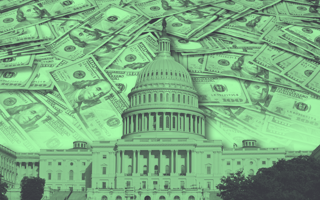There’s a key part of succeeding in the federal market that tech executives often overlook or misunderstand: end-of-year dollars.
The end of the fiscal year may seem far off right now, but the federal government consistently spends a significant chunk of its budget in its fourth quarter — between August and October — based on data from GovWin and USAspending. On average over the past five years, the Department of Defense has spent 30 percent of its budget during these last few months of the fiscal year, while the Department of Homeland Security averages 39 percent of its budget during this time. Continuing the trend, the Department of Veterans Affairs will wait to spend 43 percent of its budget until the fourth quarter, and the Department of State obligates a whopping 51 percent of its budget during this time window.
This end of year splurge is no coincidence. Federal agencies have adapted to operating under a continuing resolution in which they are working off of the previous year’s funding level, and they are highly incentivized to use their budgets in full by September 30 or lose them on October 1. This way of spending also means — and this is key — that a good chunk of federal funds remain unobligated midway through the year (that’s now) and are up for grabs.
Cutting-edge tech companies have an opportunity amid government’s end-of-year spending. If done right, the approach can lead to finally breaking into government with your first win. It’s also an opportunity to scale your prototype project and get your pilot program off the ground.
Engage Your Government Network
So where do you begin? April and May are the prime months to start hustling to rebuild relationships with your existing government customers and start targeting new ones. Many will be tempted to focus their engagement efforts on the most senior person they can get in front of. While a meeting with a general or assistant secretary may sound cool, they are not the ones buying your tech.
Stay focused on those with innovation mandates and the program offices themselves, because everything trickles up from them. In particular, any government stakeholder who ever said, “I love, I want it, but I don’t have the budget for it,” should be the first one you re-engage if for no other reason than to get back on their radar and give an update on where your company is today. These folks may well be your greatest champions, advocating for you inside the very office you’re hoping to work with.
More often than not, agencies have a wishlist of programs they’d like to fund if they can. Your goal is to get your tech solution on that list, increasing the chance it’s included in a future solicitation. Of course, these engagements won’t go anywhere if the conversation is limited to: “Here is some cool tech. It will save you tons of money.”
Instead, focus on driving an air-tight narrative for how your tech solves the stakeholders’ problems and helps them achieve their mission. Government personnel hate to be sold to. They are always looking for reliable and trustworthy partners. The moral of the story is that you should make the government stakeholders’ and contracting officers’ lives as easy as possible.
Laying the groundwork early is your best chance to see a solicitation drop in June or July with your company’s name written all over it. That’s because summer is to the federal government what the holiday season is to the rest of us: a time to start spending on products and services you’ve been eyeing all year.
Consider Strategic Teaming Opportunities
This sort of direct engagement plan isn’t the only path to capturing end-of-year dollars. Rather, it should be viewed as the first step in lining up a government customer and the right contract vehicle, which may well be one already owned by a traditional large government vendor known as system integrators. Indeed, teaming arrangements with industry partners can be the ticket to getting the dollars before they get swept.
Why go through a partner? The government loves to spend end-of-year dollars through task orders on pre-completed contracts, known as indefinite-delivery vehicles. These contract vehicles provide an easier path to obligating dollars and frequently require small business participation on them, which means large traditional government vendors have a real incentive to loop you into their proposals to gain an edge over their competitors.
Pro tip: Work backwards to identify the right industry partner by doing your due diligence to first see which contract vehicles your target government customer typically leverage for spending end-of-year money. Then see which partners are on those contracts.
It’s Not Over ’Til It’s Over
Come August and September, the window for end-of-year funds will be closing. That said, the game is not over until midnight on September 30. Tech executives looking to throw a Hail Mary here can still be successful. On average, over the past five years, the federal government has spent 16 percent of its budget in September alone!
Tech executives should plan on leveraging their existing contracting vehicles like SBIRs and OTAs. These are essentially hunting licenses to innovate and allow your government customer to buy your tech directly — perfect for last-minute government purchases.
Setting your business strategy to align with the federal budget cycle should be a consideration for every executive looking to bring cutting-edge tech into the government. Ultimately, those who act early, remain persistent and build strong relationships will be the most successful.





